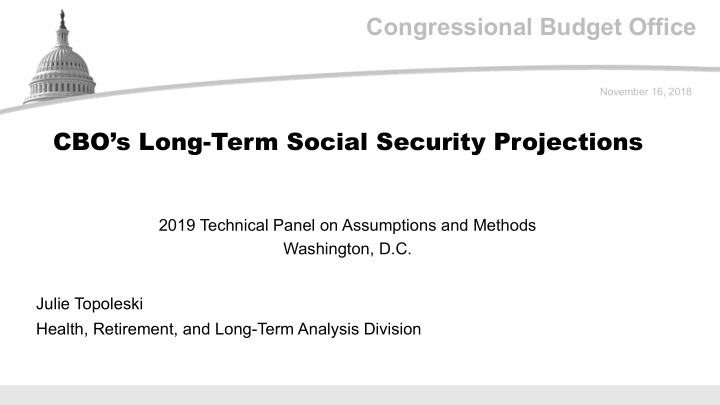



Congressional Budget Office November 16, 2018 CBO’s Long-Term Social Security Projections 2019 Technical Panel on Assumptions and Methods Washington, D.C. Julie Topoleski Health, Retirement, and Long-Term Analysis Division
CBO CBO’s long-term Social Security projections are based on a detailed microsimulation model that starts with data about individuals from a representative sample of the population and projects economic and demographic outcomes for that sample through time. 1
CBO CBO’s Long-Term Model (CBOLT) has four components: The demographic model projects the population by age and sex, using annual projections of the number of births, deaths, immigrants, and emigrants. The microsimulation model projects year-to-year changes in demographic characteristics and economic outcomes for individuals in a representative sample of the population. The long-term budget model projects federal outlays, revenues, deficits, and debt beyond CBO’s standard 10-year budget window. The policy growth model simulates how demographics, fiscal policy, and economic factors affect the U.S. economy and, in turn, the federal budget. 2
CBO Projections of economic and demographic variables are key inputs into that model. 3
CBO CBO consults a variety of sources—including its own analysis of historical data, forecasts made by other government agencies, panels of advisers , and academic literature —when creating its projections. CBO regularly reviews its projections, sometimes in light of revised and recent data and sometimes in light of recent analyses. 4
CBO Economic projections are extensions of CBO’s 10-year economic forecast, which underlies the agency’s budget projections. Those projections reflect not just historical averages but also trends that many economic forecasters expect will continue. 5
CBO Demographic variables that underlie CBO’s extended baseline: Fertility Rate Immigration Rate Mortality Rate 6
CBO Economic variables that underlie CBO’s extended baseline: Labor Force Participation Rate Unemployment Rate Growth of Total Factor Productivity Growth of Average Hours Worked Share of Earnings Below the Taxable Maximum Inflation Interest Rates 7
CBO Although long-term projections of any variable are uncertain, projections of Social Security finances are more sensitive to changes in some inputs than others. 8
CBO One way to illustrate the effect that different projections of underlying factors have on Social Security projections is to compare CBO’s projections with the Social Security Trustees’ projections . 9
CBO CBO’s and the Social Security Trustees’ Projections of Social Security Tax Revenues and Outlays Thousands 100 Series 1 75 Series 2 50 25 0 73-74 75-76 77-78 79-80 81-82 83-84 85-86 87-88 Sources: Congressional Budget Office; Social Security Trustees. 10
CBO Distribution of the Differences Between CBO’s and the Social Security Trustees’ Projections Thousands 100 Series 1 Differences in 75 projections of Series 2 four major factors account for four-fifths of 50 the difference. 25 0 73-74 75-76 77-78 79-80 81-82 83-84 85-86 87-88 Sources: Congressional Budget Office; Social Security Trustees. 11
CBO The largest effects are from differences in population and differences in earnings subject to Social Security taxes. Underlying population estimates are projections of fertility, mortality, and immigration. Earnings subject to Social Security taxes depend on the share of earnings above and below the taxable maximum, the share of total compensation paid as earnings, and total compensation as a share of GDP. 12
Recommend
More recommend